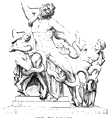Laocoön
(
Λαοκόων). A son of Priam and Hecuba, or, according to
others, of Antenor , and a priest of Apollo during the Trojan War. While offering, in the
exercise of his sacerdotal office, a bullock to render Poseidon propitious to the Trojans, two
enormous serpents issued from the sea, and, having first destroyed his two sons, whom he
vainly endeavoured to save, attacked Laocoön himself, and, winding themselves round
his body, crushed him to death in their folds. This dreadful punishment was inflicted by the
goddess Athené for the part Laocoön had taken in endeavouring to dissuade
the Trojans from admitting into Troy the famous wooden horse, which the Greeks had consecrated
to Athené (
Verg. Aen. ii. 40 foll.).
An enduring fame has been gained for the story of Laocoön, from its forming the
subject of one of the most remarkable groups in sculpture which time has spared to us. It
represents the agonized father and his youthful sons, one on each side of him, writhing and
expiring in the folds of the serpents. The figures are naked, the drapery that is introduced
being used only to support and fill up the composition. This superb work of art, which Pliny
describes inaccurately as consisting of only
 |
|
Laocoön. (Group in the Vatican.)
|
a single block of marble, originally ornamented the baths of Titus, among the ruins
of which it was found in the year 1506. The names of the sculptors who executed it are also
recorded. They are Agesander, Polydorus, and Athenodorus, natives of Rhodes. Pliny (
Pliny H. N. xxxvi. 5) says: “The
Laocoön, which is in the palace of the emperor Titus, is a work to be preferred to
all others, either in painting or sculpture. Those great artists, Agesander, Polydorus, and
Athenodorus, Rhodians, executed the principal figure and the sons and the wonderful folds of
the serpents out of one block of marble.”
This group is justly considered, by all competent judges, to be a masterpiece of art. It
combines, in its class, all that sculpture requires, and both admits of, and may truly be
studied as, a canon. The subject is of the most affecting and interesting kind; and the
expression in every part of the figures reaches, but does not exceed, the limits of propriety.
Intense mental suffering is portrayed in the countenances, while the physical strength of all
the three figures is evidently sinking under the irresistible power of the huge reptiles
wreathed around their exhausted limbs. One son, in whose side a serpent has fixed his deadly
fangs, seems to be fainting; the other, not yet bitten, tries to disengage one foot from the
serpent's embrace. The father, Laocoön, himself, is mighty in his sufferings: every
muscle is in extreme action, and his hands and feet are convulsed with painful energy. Yet
there is nothing frightful, disgusting, or contrary to beauty in the countenance. Suffering is
faithfully and strongly depicted there, but it is rather the exhibition of mental
anguish than of the repulsive and undignified contortions of mere physical pain. The whole of
this figure displays the most intimate knowledge of anatomy and of outward form; the latter
selected with care, and freed from any vulgarity of common individual nature. Indeed, the
single figure of Laocoön may be fairly referred to as one of the finest specimens
existing of that combination of truth and beauty which is so essential to the production of
perfect sculpture, and which can alone insure for it lasting admiration. The sons are of a
smaller standard than the proportion of the father—a liberty hardly justifiable, but
taken, probably, with the view of heightening the effect of the principal figure by the
so-called “pyramidal” arrangement. The right arm of Laocoö is a
restoration; but so ably done, though only in plaster, that the deficiency is said to be
scarcely a blemish. Some antiquarians have thought that the original action of the arm was not
extended, but that this limb was bent back towards the head; and they have supported their
hypothesis by the fact of there being a rough and broken surface where they think the hand, or
perhaps a fold of the serpent, may have come in contact with the hair. This view is rendered
still more probable by a smaller figure of Laocoön, now in the Museum at Naples.
Though much mutilated, it is evidently copied from the famous group, and is sufficiently
preserved to show that the arms were drawn back, as described above.
For a criticism of the work, see Lessing's
Laocoön (1766, new
ed. by Blümner, 1880); the monograph by Kekulé
(1883); and Perry's
Greek and Roman Sculpture, pp. 520-527
(1882).





